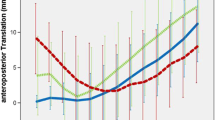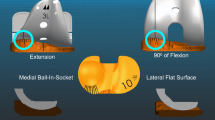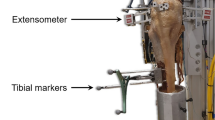Abstract
Purpose
The present study assessed the effect of insert articular surface geometry (anatomical versus conventional insert design) on anteroposterior (AP) translation and varus-valgus (VV) laxity in balanced posterior cruciate ligament (PCL) retaining total knee arthroplasty (TKA). Secondly, we evaluated if the AP translation and VV laxity in the reconstructed knee resembled the stability of the native knee.
Methods
Nine fresh-frozen full-leg cadaver specimens were used in this study. After testing the native knee, anatomical components of a PCL-retaining implant were implanted. The knee joints were subjected to anteriorly and posteriorly directed forces (at 20° and 90° flexion) and varus-valgus stresses (at 20°, 45° and 90° flexion) in both non-weightbearing and weightbearing situations in a knee kinematics simulator. Measurements were performed in the native knee, TKA with anatomical insert geometry (3° built-in varus, medial concave, lateral convex), and TKA with symmetrical insert geometry.
Results
In weightbearing conditions, anterior translations ranged between 2.6 and 3.9 mm at 20° flexion and were < 1 mm at 90° flexion. Posterior translation at 20° flexion was 2.7 mm for the native knee versus 4.0 mm (p = 0.047) and 7.0 mm (p = 0.02) for the symmetrical insert and the anatomical insert, respectively. Posterior translation at 90° flexion was < 1.1 mm and not significantly different between the native knee and insert types.
In non-weightbearing conditions, the anterior translation at 20° flexion was 5.9 mm for the symmetrical and 4.6 mm for the anatomical insert (n.s.), compared with 3.0 mm for the native knee (p = 0.02). The anterior translation at 90° flexion was significantly higher for the reconstructed knees (anatomical insert 7.0 mm; symmetrical insert 9.2 mm), compared with 1.6 mm for the native knee (both p = 0.02). Varus-valgus laxity at different flexion angles was independent of insert geometry. A valgus force in weightbearing conditions led to significantly more medial laxity (1°–3° opening) in the native knee at 45° and 90° flexion compared with the reconstructed knee for all flexion angles.
Conclusions
Insert geometry seems to have a limited effect with respect to AP translation and VV laxity, in the well-balanced PCL-retaining TKA with an anatomical femoral component. Secondly, AP translation and VV laxity in the reconstructed knee approximated the laxity of the native knee.



Similar content being viewed by others
References
Arnout N, Victor J, Vermue H, Pringels L, Bellemans J, Verstraete MA (2020) Knee joint laxity is restored in a bi-cruciate retaining TKA-design. Knee Surg Sports Traumatol Arthrosc 28:2863–2871
Banks S, Bellemans J, Nozaki H, Whiteside LA, Harman M, Hodge WA (2003) Knee motions during maximum flexion in fixed and mobile-bearing arthroplasties. Clin Orthop Relat Res 410:131–138
Barnes CL, Blaha JD, DeBoer D, Stemniski P, Obert R, Carroll M (2012) Assessment of a medial pivot total knee arthroplasty design in a cadaveric knee extension test model. J Arthroplasty 27(1460–1468):e1461
Baumann F, Bahadin O, Krutsch W, Zellner J, Nerlich M, Angele P et al (2017) Proprioception after bicruciate-retaining total knee arthroplasty is comparable to unicompartmental knee arthroplasty. Knee Surg Sports Traumatol Arthrosc 25:1697–1704
Halewood C, Traynor A, Bellemans J, Victor J, Amis AA (2015) Anteroposterior laxity after bicruciate-retaining total knee arthroplasty is closer to the native knee than ACL-resecting TKA: a biomechanical cadaver study. J Arthroplasty 30:2315–2319
Heesterbeek PJ, Labey L, Wong P, Innocenti B, Wymenga AB (2014) A new spacer-guided, PCL balancing technique for cruciate-retaining total knee replacement. Knee Surg Sports Traumatol Arthrosc 22:650–659
Heyse TJ, Slane J, Peersman G, Dirckx M, van de Vyver A, Dworschak P et al (2017) Kinematics of a bicruciate-retaining total knee arthroplasty. Knee Surg Sports Traumatol Arthrosc 25:1784–1791
Hunt NC, Ghosh KM, Blain AP, Athwal KK, Rushton SP, Amis AA et al (2014) How does laxity after single radius total knee arthroplasty compare with the native knee? J Orthop Res 32:1208–1213
Hunt NC, Ghosh KM, Blain AP, Rushton SP, Longstaff LM, Deehan DJ (2015) No statistically significant kinematic difference found between a cruciate-retaining and posterior-stabilised triathlon knee arthroplasty: a laboratory study involving eight cadavers examining soft-tissue laxity. Bone Joint J 97-B:642–648
Jones CW, Jacobs H, Shumborski S, Talbot S, Redgment A, Brighton R et al (2020) Sagittal stability and implant design affect patient reported outcomes after total knee arthroplasty. J Arthroplasty 35:747–751
Lo J, Muller O, Dilger T, Wulker N, Wunschel M (2011) Translational and rotational knee joint stability in anterior and posterior cruciate-retaining knee arthroplasty. Knee 18:491–495
Matsumoto K, Ogawa H, Yoshioka H, Akiyama H (2017) Postoperative anteroposterior laxity influences subjective outcome after total knee arthroplasty. J Arthroplasty 32:1845–1849
Mihalko WM, Creek AT, Mary MN, Williams JL, Komatsu DE (2011) Mechanoreceptors found in a posterior cruciate ligament from a well-functioning total knee arthroplasty retrieval. J Arthroplasty 26:504.e9-504.e12
Roth JD, Howell SM, Hull ML (2015) Native knee laxities at 0 degrees, 45 degrees, and 90 degrees of flexion and their relationship to the goal of the gap-balancing alignment method of total knee arthroplasty. J Bone Joint Surg Am 97:1678–1684
Seah RB, Pang HN, Lo NN, Chong HC, Chin PL, Chia SL et al (2012) Evaluation of the relationship between anteroposterior translation of a posterior cruciate ligament-retaining total knee replacement and functional outcome. J Bone Joint Surg Br 94:1362–1365
Seah RB, Yeo SJ, Chin PL, Yew AK, Chong HC, Lo NN (2014) Evaluation of medial-lateral stability and functional outcome following total knee arthroplasty: results of a single hospital joint registry. J Arthroplasty 29:2276–2279
Seon JK, Park SJ, Yoon TR, Lee KB, Moon ES, Song EK (2010) The effect of anteroposterior laxity on the range of movement and knee function following a cruciate-retaining total knee replacement. J Bone Joint Surg Br 92:1090–1095
Victor J, Bellemans J (2006) Physiologic kinematics as a concept for better flexion in TKA. Clin Orthop Relat Res 452:53–58
Victor J, Labey L, Wong P, Innocenti B, Bellemans J (2010) The influence of muscle load on tibiofemoral knee kinematics. J Orthop Res 28:419–428
Victor J, Van Glabbeek F, Vander Sloten J, Parizel PM, Somville J, Bellemans J (2009) An experimental model for kinematic analysis of the knee. J Bone Joint Surg Am 91(Suppl 6):150–163
Wautier D, Thienpont E (2017) Changes in anteroposterior stability and proprioception after different types of knee arthroplasty. Knee Surg Sports Traumatol Arthrosc 25:1792–1800
Wymenga AB, Heesterbeek PJ (2017) Preserving the posterior cruciate ligament. Insall Scott Surg Knee 2017:1509–1518
Yoshiya S, Matsui N, Komistek RD, Dennis DA, Mahfouz M, Kurosaka M (2005) In vivo kinematic comparison of posterior cruciate-retaining and posterior stabilized total knee arthroplasties under passive and weight-bearing conditions. J Arthroplasty 20:777–783
Acknowledgements
We thank Ronny De Corte from the European Centre for Knee Research (EKCR) for his help in preparation, implantation and measurements of the specimens. Specimens and materials used in this study were kindly arranged by the European Centre for Knee Research, Smith and Nephew.
Author information
Authors and Affiliations
Contributions
Study conception and design: A.H.v.H., P.J.C.H., L.L., A.B.W. Acquisition of data: P.J.C.H., L.L., A.B.W. Analysis and interpretation of data: A.H.v.H., P.J.C.H, G.H. Drafting of manuscript: A.H.v.H. Critical revision: P.J.C.H., G.H., L.L., A.B.W.
Corresponding author
Ethics declarations
Conflict of Interest
The authors declare that they have no conflict of interest.
Funding
Specimen and materials used in this study were arranged by the former European Center of Knee Research (owned by Smith & Nephew). Smith & Nephew partially financed this study (payment to institution of author).
Ethical approval
Not applicable.
Informed consent
Not applicable.
Additional information
Publisher's Note
Springer Nature remains neutral with regard to jurisdictional claims in published maps and institutional affiliations.
Rights and permissions
About this article
Cite this article
van Houten, A.H., Heesterbeek, P.J.C., Hannink, G. et al. Limited effect of anatomical insert geometry on in vitro laxity in balanced anatomic posterior cruciate ligament retaining total knee arthroplasty. Knee Surg Sports Traumatol Arthrosc 30, 1273–1281 (2022). https://doi.org/10.1007/s00167-021-06564-1
Received:
Accepted:
Published:
Issue Date:
DOI: https://doi.org/10.1007/s00167-021-06564-1




